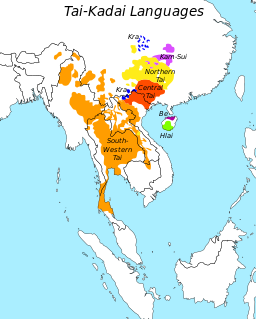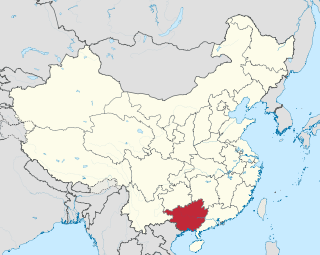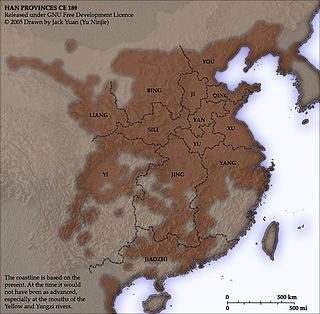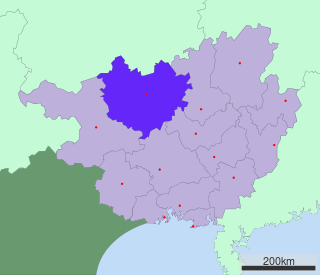
Baise, or Bose, is the westernmost prefecture-level city of Guangxi, China bordering Vietnam as well as the provinces of Guizhou and Yunnan. The name is from Youjiang Zhuang Baksaek, meaning "in, or blocking, a mountain pass".
Rauz, Liao, or Lao peoples is an ethnic cluster covering Zhuang, Buyei, Tay–Nùng, and other northern Tai language-speaking peoples. These peoples are inclined to call themselves as Rauz which means "we" or "our people".
The Kam–Sui languages are a branch of the Kra–Dai languages spoken by the Kam–Sui peoples. They are spoken mainly in eastern Guizhou, western Hunan, and northern Guangxi in southern China. Small pockets of Kam–Sui speakers are also found in northern Vietnam and Laos.

Mashan County is under the administration of Nanning, the capital of Guangxi Zhuang Autonomous Region, China. The northernmost county-level division of Nanning City, it borders the prefecture-level cities of Hechi to the north and Laibin to the northeast.

Liujiang District is under the administration of Liuzhou, Guangxi Zhuang Autonomous Region, China, located on the southwest bank of the Liu River. It covers a land area of 2,539.16 square kilometres (980.38 sq mi) and had a population of 562,351 as of 2010. The southernmost county-level division of Liuzhou City, it lies south of Liuzhou's city proper, bordering the prefecture-level cities of Laibin to the south and Hechi to the northwest.

Tian'e is a county of northwestern Guangxi, China, located on the upper reaches of the Hongshui River and bordering Guizhou province to the northwest. It is under the administration of the prefecture-level city of Hechi.

Jinchengjiang is a district and the seat of Hechi, Guangxi, People's Republic of China.

The Long River is a river system in northern Guangxi Province, China. It is a part of the larger Pearl River system by way of the Liu, Qian, Xun, and Xi Rivers. Its true source is in Sandu Shui Autonomous County, Guizhou, where it is known as the Dagou He. It becomes the Jincheng Jiang after entering Guangxi and passes through Hechi. After joining with its left tributary, the Xiaohuan Jiang, it becomes known as the Long Jiang. It then passes through Yizhou before meeting with the Rong Jiang to become the Liu.
The Maonan language is a Kam–Sui language spoken mainly in Huanjiang Maonan Autonomous County, Hechi, northern Guangxi by the Maonan people.

Hechi Jinchengjiang Airport is an airport serving in the city of Hechi in Guangxi Zhuang Autonomous Region, China. It is built on the Jiantang Mountain, in Hechi Town, Jinchengjiang District, 40 kilometres (25 mi) from the city center. With at an elevation of 677 metres (2,221 ft), it is the highest airport in Guangxi.

The Northern Tai languages are an established branch of the Tai languages of Southeast Asia. They include the northern Zhuang languages and Bouyei of China, Tai Mène of Laos and Yoy of Thailand.
The Xong language, is the northern-most Hmongic language, spoken in south-central China by ca 0.9 million people. It's called Xiangxi Miaoyu (湘西苗语), Western Hunan Miao, in Chinese. In Western sources, it's been called Eastern Miao, Meo, Red Miao and North Hmongic. The official alphabet was adopted in 1956.
Li Jiheng is a Chinese politician and serving as the Communist Party Secretary of Inner Mongolia. He is the former Communist Party Chief and Governor of Yunnan province and a former Deputy Party Chief of Guangxi Zhuang Autonomous Region.

The Guizhou–Guangxi railway or Qian'gui railway, is a single-track electrified railroad in Southwest China between Guiyang in Guizhou Province and Liuzhou in Guangxi Zhuang Autonomous Region. The shorthand name for the line, Qiangui, is derived from the shorthand names of Guizhou and Guangxi.
Yi Prefecture or Yizhou may refer to:

Guangxi ( ; formerly romanised as Kwangsi; Chinese: 广西; Zhuang: Gvangjsih, officially the Guangxi Zhuang Autonomous Region, is an autonomous region of the People's Republic of China, located in south China and bordering Vietnam. Formerly a province, Guangxi became an autonomous region in 1958.

Yizhou or Yi Prefecture was a zhou (prefecture) in imperial China centering on modern Linyi, Shandong, China. It existed (intermittently) from 578 until 1734, when it was recreated as Yizhou Prefecture by the Qing dynasty.














